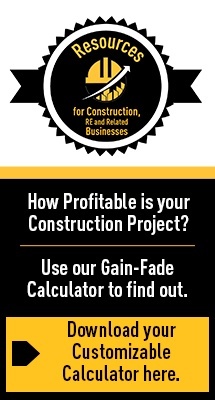 Have you ever completed a job only to realize that the cost of performing the work equals or exceeds the revenue that the project brought in? This phenomenon is called "profit fade" and, if it occurs repeatedly, it can prove fatal to your business.
Have you ever completed a job only to realize that the cost of performing the work equals or exceeds the revenue that the project brought in? This phenomenon is called "profit fade" and, if it occurs repeatedly, it can prove fatal to your business.
Although profit fade could threaten any construction business, it's a particular concern for contractors who undertake long, complex projects. Calculating costs and predicting revenue for these jobs can be difficult because materials costs can rise during the project and unforeseen conditions — such as bad weather — can affect project schedules.
Estimate Accurately
The first step to curtailing profit fade is to produce accurate project estimates. Does that sound easier said than done? Most project losses can be traced back to bid errors, so focus on eliminating them.
Your estimates should be detailed, so that they don't underestimate materials, labor or indirect costs associated with a job. Also, consider reserving at least 5% of the project budget for surprise costs, such as delays due to weather or site issues or to problems such as poor subcontractor performance.
And, if you don't already, adopt the practice of job costing — coding and calculating the cost of specific activities or tasks — to identify which tasks are making money, and which aren't. This way you can say "no" to jobs that won't pay the bills.
READ MORE: Construction Companies: Use a Gain-Fade Analysis to Boost Profitability
Define Contract Terms
 Well-defined contract terms and conditions are another way to minimize the incidence of profit fade. For example, contracts with subcontractors should include provisions outlining your rights to:
Well-defined contract terms and conditions are another way to minimize the incidence of profit fade. For example, contracts with subcontractors should include provisions outlining your rights to:
- Supplement work and be reasonably reimbursed if the sub performs inadequately,
- Suspend the sub's performance, and
- Terminate the contract.
In some cases, contracts should also require subs to buy surety bonds or subcontractor default insurance.
As for contracts with owners, the language should first and foremost clearly define the agreed-upon scope and nature of the work you'll perform. Include a clause that limits how much (if anything) an owner can change while work is in progress before paying additional compensation. From there, establish a clear process for change orders and approvals that allows you to bill an owner for approved changes as soon as possible.
To better manage materials costs, consider including a price acceleration provision in contracts with owners that allows you to adjust the contract price if materials prices increase over the course of the project. Some contractors also add contract language asking for a deposit to buy and store materials before work begins.
READ MORE: Construction: Prequalify Subcontractors to Protect Your Profitability
Manage Costs
Managing materials costs can get tricky — especially as the COVID-19 pandemic continues to disrupt supply chains. So, when bidding on a project, include a backup plan of two or more alternative suppliers. Try to include at least one that's local. If feasible, build up inventory levels with critical materials and long-lead items to insulate your business against supply chain problems.
Of course, the best way to prevent profit fade is to closely monitor costs throughout the entire construction process. Tracking costs in real time enables you to recognize problems early so you can act immediately to correct course.
Doing so must be a team effort. Train your project managers to compare labor time cards and materials invoices against a job's budget to assess progress. Monitoring project costs in this manner brings you back full circle to the estimating process. Knowing and documenting actual costs of current jobs should lead to more accurate estimates for future ones.
Project managers should also communicate effectively with their crews to catch expenses that are starting to get out of hand. And, last but certainly not least, managers need to work well with your accounting team to fully understand the budget and use funds optimally.
Your Role
As a construction business owner or executive, your role is to see the big picture. As each job is completed, compare estimated costs to actual costs to determine what led to a healthy profit margin or, conversely, to cost overruns and profit fade. Once you identify areas for improvement, you can take steps to address shortcomings in your operations or avoid the types of jobs that will likely lead to losses.
Contact us for help evaluating your construction company's estimating and bidding practices, as well as for suggestions on how to prevent profit fade and boost the bottom line.
© 2021





